See how biblical figures transformed trials into triumphs through gratitude, inspiring a closer look at the strength found in thanksgiving.
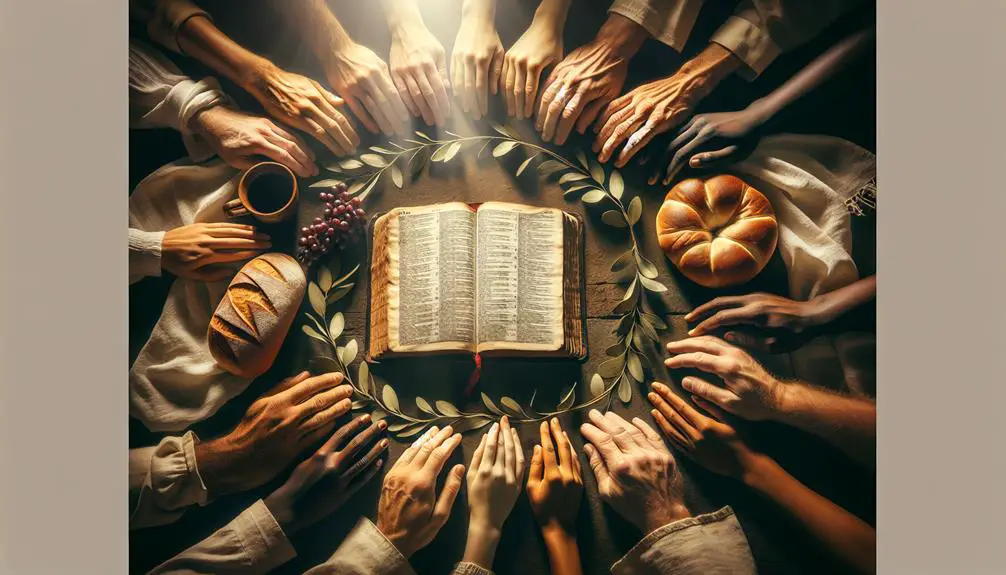
People Who Gave Thanks in the Bible
Imagine you're King David, standing in the vast wilderness, composing your heart out in Psalms of gratitude to God. Your situation, like his, may not always be ideal, yet there's a compelling draw to give thanks amidst it all.
This historical example sets the stage for a profound exploration into the lives of biblical figures who found strength and solace in thanksgiving. From Jesus giving thanks before performing miracles to Paul's heartfelt letters of gratitude, there's an untold power in their actions that might just change the way you view your own challenges.
Why did they choose gratitude, and what can you learn from their experiences?
Key Takeaways
- Gratitude in biblical narratives often precedes divine intervention and miracles, reinforcing its spiritual significance.
- Figures like Job, Daniel, and King David illustrate gratitude as a resilient response to both blessings and trials.
- Jesus' acts of gratitude, particularly before performing miracles, highlight the deep connection between thanksgiving and divine favor.
- Expressing gratitude fosters community bonds, humility, and acknowledges the omnipotence and benevolence of the Divine in biblical stories.
King David's Psalms of Gratitude
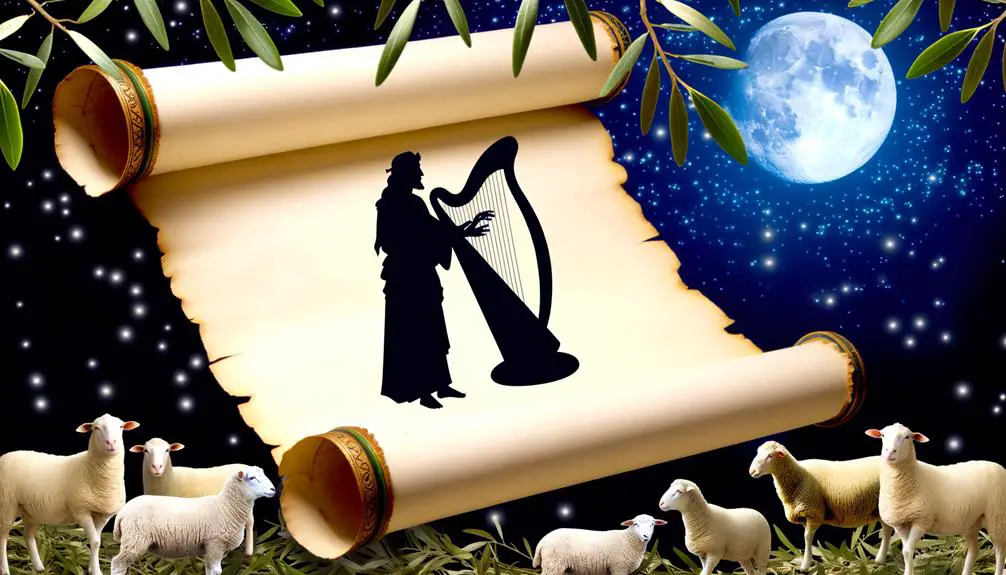
King David's Psalms of Gratitude exemplify a profound expression of thanksgiving, woven through the fabric of biblical literature with sincerity and depth. These psalms aren't mere words; they represent a dynamic form of musical worship and heartfelt adoration, deeply embedded in the tradition of expressing thanks to God.
Analyzing these texts, you'll notice that David's gratitude isn't superficial. It stems from a recognition of God's omnipotence and benevolence, as well as a personal reflection on his own life's journey, marked by trials and triumphs. This dual awareness is crucial to understanding the depth of his thanksgiving. David's use of musical worship as a vehicle for his gratitude underscores the integral role of arts in spiritual expression. Music, for David, isn't an accessory to worship; it's a fundamental mode of connecting with the divine, enhancing the sincerity and intensity of his adoration.
Furthermore, the heartfelt adoration evident in these psalms transcends mere acknowledgment of God's acts. It reflects a profound engagement with the divine character, recognizing God's steadfast love, mercy, and faithfulness. David's expression of thanks, therefore, isn't just for what God has done but for who God is. This distinction is vital in appreciating the depth of biblical gratitude exemplified by David.
In essence, King David's Psalms of Gratitude offer a rich, multifaceted template for thanksgiving. They invite a deep, reflective engagement with the divine, mediated through musical worship and characterized by heartfelt adoration, setting a timeless standard for expressing gratitude.
Jesus Thanks God Before Miracles
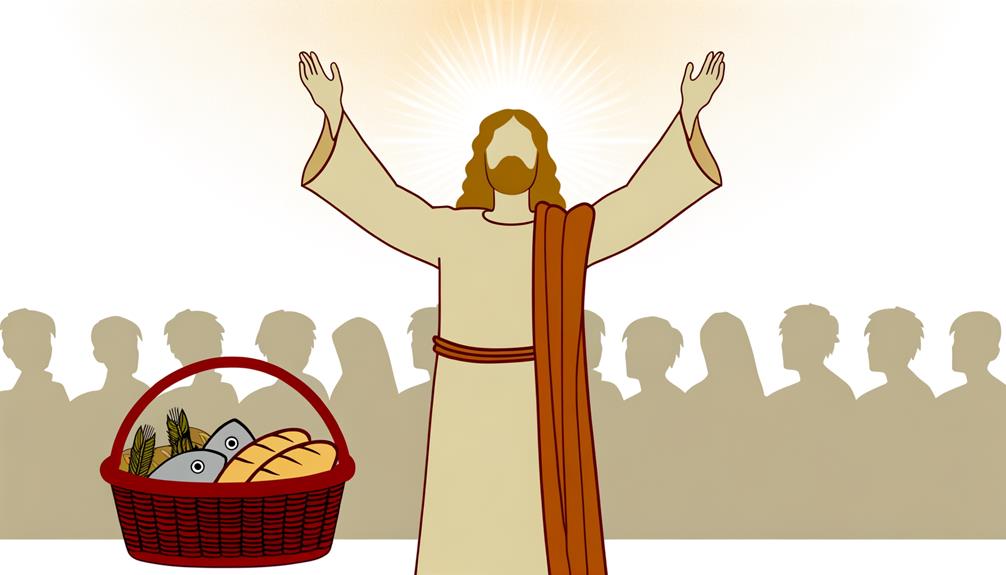
Examining the biblical narratives, it's evident that Jesus often gave thanks to God before performing miracles, highlighting a deliberate act of gratitude that precedes divine intervention. This practice of miraculous gratitude not only emphasizes the close relationship between Jesus and the Father but also serves as a model for believers in acknowledging God's sovereign power before witnessing His works.
The instances of Jesus expressing thanks before miracles can be considered under four main scenarios:
- Feeding of the 5,000: Before the multiplication of loaves and fishes, Jesus looked up to heaven and gave thanks. This act of divine anticipation set the stage for one of the most well-known miracles, demonstrating the power of gratitude in multiplying resources.
- Raising of Lazarus: Before commanding Lazarus to come out of the tomb, Jesus thanked God for hearing Him, showing faith in God's willingness to intervene and showcasing the significance of gratitude in the face of impossibility.
- The Last Supper: Jesus gave thanks before breaking bread and sharing wine, symbolizing His body and blood. This moment of gratitude, preceding the sacrifice for humanity's salvation, underscores the profound relationship between thanksgiving and redemptive miracles.
- Healing the Ten Lepers: Though not directly before the miracle, Jesus' interaction with the ten lepers highlights the integral role of gratitude in healing and divine intervention.
Through these examples, it's clear that Jesus' thankful prayers aren't mere formalities but acts of faith and recognition of God's omnipotence, setting a paradigm of miraculous gratitude and divine anticipation for all believers.
Job's Thanksgiving in Suffering
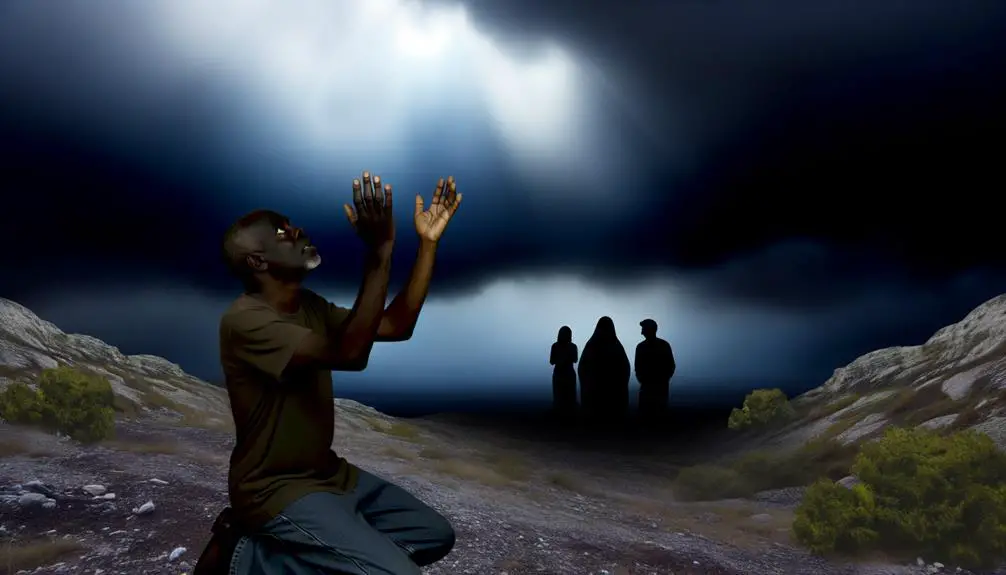
You'll find Job's story compelling as it showcases his unwavering faith amidst profound suffering. His endurance and gratitude, even when faced with significant loss, offer profound lessons on resilience and thankfulness.
Analyzing Job's response provides insight into the complexity of human faith and the power of maintaining a thankful heart under dire circumstances.
Job's Unwavering Faith
Amidst devastating loss and suffering, Job's steadfast faith and his choice to give thanks to God exemplify a profound lesson in spiritual resilience. Job's integrity and understanding of suffering's purpose shine through, highlighting:
- Job's unwavering trust in God, despite immense personal loss, showcases his exceptional faith.
- His refusal to curse God, even when advised to do so, underscores his deep reverence and loyalty.
- The dialogue between Job and his friends reveals a complex understanding of divine justice and human suffering.
- Job's eventual restoration, interpreted by some as divine vindication, serves not only as a testament to his faith but also as a narrative of hope and redemption for believers facing trials.
Job's story teaches that true faith remains unshaken, even in the face of inexplicable suffering.
Lessons in Endurance
Job's thanksgiving amidst suffering offers a poignant lesson in enduring faith, illustrating how gratitude can coexist with pain. This narrative serves as a powerful case study in the application of gratitude exercises and endurance strategies within the context of profound personal trials.
Analyzing Job's response to his adversities reveals a disciplined practice of gratitude, not as a denial of hardship, but as a framework for navigating through it. Such endurance strategies, rooted in a steadfast acknowledgment of blessings amidst turmoil, provide a blueprint for sustaining faith under pressure.
Job's example underscores the importance of cultivating a gratitude practice as a foundational element of resilience, demonstrating that even in the depths of despair, one can find reasons for thanksgiving, reinforcing the capacity to endure.
Gratitude Amid Loss
Building on the foundation of endurance, we now explore how Job's expression of gratitude during his suffering offers profound insights into coping with loss. His story parallels the profound moments of thanksgiving expressed through Hannah's prayer and Solomon's dedication, illustrating a universal theme of gratitude amidst adversity.
Analyzing Job's response reveals:
- Recognition of Sovereignty: Like Solomon's dedication, Job acknowledges a higher power's dominion over his circumstances.
- Humility in Suffering: Job's posture mirrors Hannah's humility in her prayer, emphasizing reliance on divine intervention.
- Transformation Through Trial: Job's ordeal, akin to purification rituals, signifies personal growth through hardship.
- Legacy of Faith: Job's unwavering faith, despite loss, leaves a legacy of spiritual resilience, echoing the enduring faith found in Hannah's and Solomon's stories.
Daniel's Prayers of Thanks

Daniel's consistent prayers of thanks, despite facing life-threatening challenges, highlight his unwavering faith and gratitude towards God. His story, embedded within the Hebrew Bible's narrative, showcases a profound relationship with the Divine, marked by dream interpretations and angelic visitations. These elements aren't mere plot devices but serve as testimonials of Daniel's spiritual perseverance and the acknowledgment of God's omnipotence.
Notably, Daniel's interpretative prowess regarding the dreams of Nebuchadnezzar not only averts disaster but also positions him as a conduit of God's wisdom. This scenario underscores a dual-layer of thanksgiving—Daniel's gratitude towards God for imparting wisdom and insight, and Nebuchadnezzar's eventual acknowledgment of God's supreme power. Such instances exemplify the symbiotic relationship between divine favor and human acknowledgment through thanks.
Moreover, angelic visitations in Daniel's life, particularly during his time in the lions' den, epitomize divine intervention and protection. These moments, fraught with peril, transform into profound opportunities for expressing gratitude. Daniel's deliverance, hence, isn't merely a personal victory but a testament to the efficacy of faith and thanks in navigating adversity.
In analyzing Daniel's prayers of thanks, it's pivotal to recognize that his gratitude isn't reactive but a constant, defining feature of his faith. It's an acknowledgment of God's enduring presence, transcending mere survival to encompass wisdom, protection, and the fulfillment of God's will. Daniel's story, thus, serves as a compelling narrative on the power of gratitude in fostering a resilient and devout spiritual journey.
The Leper Who Returned to Jesus
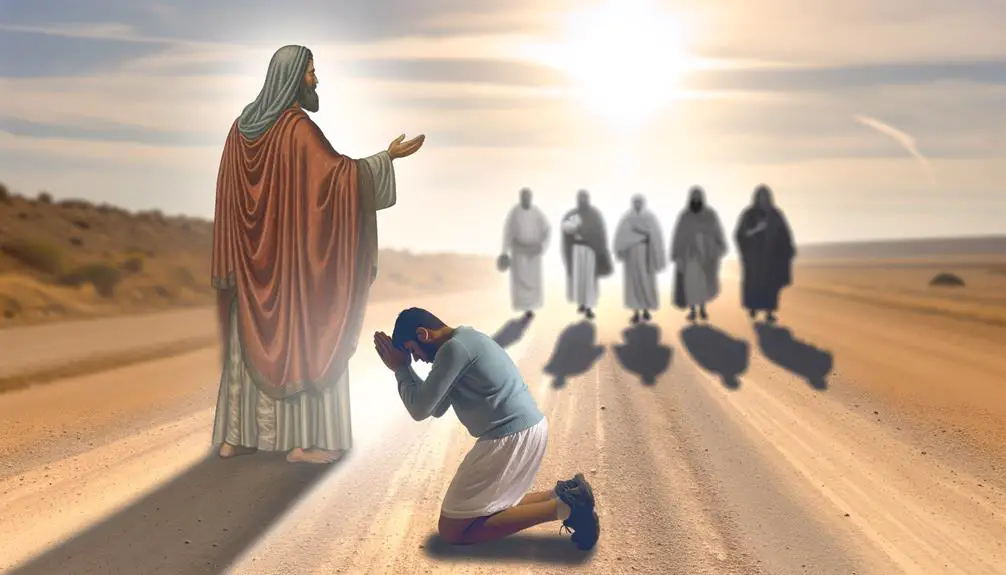
You must now turn your attention to the narrative of the leper who returned to Jesus, a distinctive account of gratitude within the biblical texts. This story not only highlights the act of healing performed by Jesus on ten lepers but also underscores the singular leper's act of returning to express gratitude, setting him apart from the others.
Analyzing this incident reveals the profound impact of thanksgiving on both the giver and receiver, offering insights into the dynamics of gratitude in spiritual contexts.
Leper's Grateful Return
Among the narratives in the New Testament, the story of the leper who returned to express gratitude to Jesus stands out as a profound example of thankfulness and recognition of divine healing.
- Social Stigma: The leper's return breaks the conventional barriers of isolation, showcasing a bold move against societal norms that ostracized those with leprosy.
- Healing Process: His healing wasn't just physical but also social and emotional, reinstating him into the community.
- Gratitude: The act of returning to give thanks highlights the importance of acknowledging one's benefactor, emphasizing humility and gratitude.
- Divine Recognition: By thanking Jesus, the leper acknowledges the source of his healing as divine, setting a precedent for recognizing and appreciating miraculous interventions.
Jesus Heals Ten Lepers
Building on the theme of gratitude and divine intervention illustrated by the solitary leper, the narrative of Jesus healing ten lepers further exemplifies the profound expressions of thankfulness and the rarity of its occurrence. This account, deeply rooted in historical and cultural contexts, underscores the severe leprosy stigma that marginalized individuals, isolating them from their communities and religious practices. Among the ten healed, only one, a Samaritan outlier, returns to express gratitude to Jesus.
This Samaritan's action not only breaches the prevailing leprosy stigma but also cultural and religious boundaries, highlighting the unexpected source of thankfulness. Analyzing this episode reveals the complexities of social ostracization and the transformative power of gratitude, especially when it transcends societal divisions.
Thanksgiving's Impact on Jesus
Reflecting on the solitary leper's return to Jesus, one observes a significant moment that illuminates the impact of gratitude on the healer himself. This encounter underscores the profound effects of thanksgiving, not just on the giver but also on the receiver. Through this lens, consider the following:
- Acknowledgment of Healing: The leper's return to express gratitude highlights the recognition of Jesus' divine intervention.
- Cultivation of Humility: Jesus' acceptance of thanks underlines the importance of humility in leadership.
- Reinforcement of Gratitude Practices: This incident exemplifies how thanksgiving rituals can reinforce communal bonds.
- Inspiration for Others: The act serves as a powerful example for others to follow, showcasing the value of expressing gratitude even in moments of personal triumph.
Paul's Letters of Thanksgiving

Why did Paul consistently express gratitude in his epistles, and what does this reveal about the early Christian community's values? Paul's letters, rich with expressions of thanksgiving, reflect a foundational aspect of the early Christian ethos: a deep-seated value for community, mutual support, and the acknowledgment of God's presence in their lives. Through his mentorship and Apostolic journeys, Paul cultivated relationships that were deeply rooted in faith, gratitude, and mutual edification. This consistent expression of thanks wasn't merely a personal habit but a deliberate effort to model and reinforce the importance of gratitude within the Christian community.
Paul's gratitude served multiple purposes. It reinforced the bonds of fellowship, acknowledged the contributions of individuals and communities to the mission, and celebrated the grace of God at work. This framework of thankfulness was crucial for nurturing the early church's identity, resilience, and mission.
Epistle |
Recipients |
Key Themes of Thanksgiving |
|---|---|---|
1 Thessalonians |
Church in Thessalonica |
Faithfulness, Love, Hope in Persecution |
Philippians |
Church in Philippi |
Joy, Partnership in the Gospel, Mutual Support |
Philemon |
Philemon |
Love, Faith, Refreshment of the Believers' Hearts |
These letters, among others, illustrate Paul's strategic use of gratitude to teach, to build up, and to encourage. His thanksgiving goes beyond mere politeness; it's an essential tool for spiritual formation and community building. Paul's example prompts a reevaluation of gratitude's role in Christian life, suggesting it's not only a response to God's grace but a foundational principle for Christian fellowship and mission.
Frequently Asked Questions
How Do Modern Theologians Interpret the Significance of Gratitude in the Context of Biblical Narratives, Especially in Relation to Contemporary Practices of Thanksgiving?
You might find that modern theologians see gratitude's role in biblical narratives as deeply intertwined with both spiritual and physical well-being, reflecting a broader understanding of gratitude physiology.
They often draw parallels between ancient expressions of thanks and today's Thanksgiving practices, including the sharing of meals.
This connection isn't just about replicating Thanksgiving recipes but embodies a deeper, transformative expression of thankfulness that resonates with contemporary efforts to cultivate a thankful heart and community.
Are There Any Recorded Instances Where Followers of Other Religions or Cultures Within the Biblical Timeline Expressed Gratitude in a Manner Similar to the Biblical Figures, and How Were These Instances Documented or Acknowledged?
Yes, within the rich tapestry of history, other religions and cultures have woven their own threads of gratitude expressions, mirroring those of biblical figures.
These instances, often encapsulated in cultural rituals, are meticulously documented through ancient texts, artifacts, and oral traditions.
They underscore a universal appreciation for life's gifts, irrespective of religious boundaries.
Analyzing these practices offers a scholarly lens through which to view the multifaceted nature of gratitude across civilizations.
How Has the Concept of Gratitude Expressed in the Bible Influenced the Development of Gratitude Practices in Other Non-Christian Religious Traditions?
You're exploring how biblical gratitude has shaped non-Christian traditions through cultural syncretism and interfaith dialogues. This influence demonstrates a shared human desire to express thanks, transcending religious boundaries.
In What Ways Have Psychological Studies on Gratitude Been Linked to or Influenced by the Depictions of Thanksgiving in Biblical Stories?
You're diving into an ocean of wisdom when exploring how psychological studies on gratitude resonate with ancient narratives. Researchers have unearthed fascinating links, especially in practices like gratitude journaling, which echoes centuries-old traditions.
These studies don't just warm the heart; they reveal neurological effects that transform brain function. Analyzing this, you'll find a scholarly bridge connecting modern science with timeless tales, showcasing how ancient wisdom informs contemporary understanding of gratitude's power.
Can the Act of Giving Thanks as Depicted in the Bible Be Seen as a Form of Resistance or Protest Against the Prevailing Circumstances of the Individuals Expressing It, and How Is This Perspective Supported Within Biblical Scholarship?
You might find that gratitude, as you understand it within psychology, takes on a deeper meaning when seen as a form of resistance.
This concept, deeply rooted in resistance theology, suggests that expressing thanks in adverse situations isn't just about feeling good—it's a deliberate act against prevailing hardships.
Biblical scholarship supports this view, showing how such expressions of gratitude can indeed serve as a potent form of protest or resistance.
Conclusion
In weaving through the fabric of biblical narratives, one discerns a golden thread of gratitude that binds the human to the divine. From King David's harmonious psalms to Paul's epistolary expressions of thanks, each instance serves as a testament to a profound recognition of God's omnipresence in trials and triumphs alike.
This thematic resonance not only enriches the biblical tapestry but also offers a reflective mirror to contemporary readers, urging a rekindling of gratitude in the human spirit.

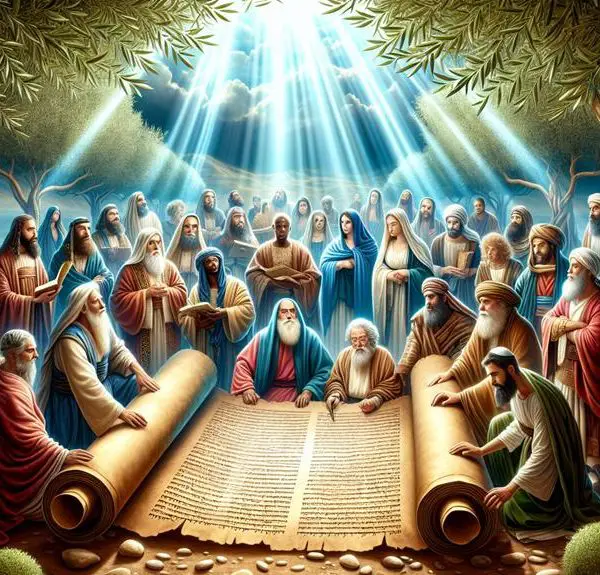

Sign up